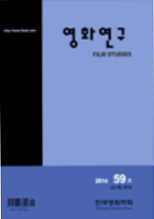- 영문명
- Reinterpretation about the Narrative Structure of 8½ by Federico Fellini: Argument with Christian Metz’s interpretation
- 발행기관
- 한국영화학회
- 저자명
- 노철환
- 간행물 정보
- 『영화연구』제59호, 63~96쪽, 전체 34쪽
- 주제분류
- 예술체육 > 예술일반
- 파일형태
- 발행일자
- 2014.03.31
6,880원
구매일시로부터 72시간 이내에 다운로드 가능합니다.
이 학술논문 정보는 (주)교보문고와 각 발행기관 사이에 저작물 이용 계약이 체결된 것으로, 교보문고를 통해 제공되고 있습니다.

국문 초록
영문 초록
It is possible to figure out indirectly how a director has used thecameras through the images shown in a film. This study which is relatedto the camera is begun as a reinterpretation of Lasswell’s CommunicationModel (5W) : Who / Say What / In Which Channel / To Whom / WithWhat Effect. We try to answer this key question : “How does the directorexpresses his intention to the spectators through the camera?”We define the films that have the following characteristics as the filmsur le film, film on film in English: a fiction film, a film directed by the‘auteur’, treatment of the process of the film production, presentation ofthe film dans le film, film in film in English, and the existence ofdirector’s reflexive character. To respond the key question, we analyze 8 ½(1963) by Federico Fellini which is his first film sur le film. 8 ½ has one of the most complex narratives in the film history. Christian Metz named it as a ‘twice double layered film.’ In particular,interpretations on the last sequence of the film which is really verystubborn in its decomposition, are still divided. The most controversialpoint is whether Guido directed the film or pretended to shoot it. Although many scholars have tried to unveil the secrets of this sequence,still there was no clear interpretation in the past 60 years. For exampleMetz said, “8 ½, we do not even see Guido was shooting this film…”However, We don’t agree to his contention. Our hypothesis as follows: “If we found some cameras taking the shotand the shot filmed by them, then we would finally have validatedGuido’s action as the direction of the film.” To prove this hypothesis, weintroduce another notion, film dans le film : a part of film sur le film, itsindependent narrative, the exposure of the scene of production or ofprojection, the existence of filming camera, etc. After all possible checks, we propose a redefinition of the narrativestructure of 8 ½. With this study we want to suggest a new method offilm analysis to approach the director’s intention.
목차
1. 서론
2. <8½>의 내러티브구조
3. 새로운 개념의 도입 : 영화에 대한 영화/영화 속 영화
4. 마지막 시퀀스 분석 : 쇼트 768-773
5. 내러티브 구조의 재구성
6. 결론
키워드
해당간행물 수록 논문
- SF 영화의 다문화(주의)적 시선
- 전후(戰後)의 한⋅중⋅일 멜로드라마 비교연구
- 영화음악 공연사용료 소송을 통해서 본 영화의 저작권법적 쟁점
- 문화영화의 제도화 과정
- 1960년대 쿠바영화에서의 혁명수용 형태 연구
- 한국 실험영화 감독들의 장르정체성과 해외경험에 따른 미학적, 제도적 인식의 차이
- 식민지 조선의 발성영화 상영에 대한 역사적 연구
- 경성고등연예관 연구
- 오디션 연기의 미학과 방법론 연구
- 소설 <재능 있는 리플리 The Talented Mr. Ripley>와 각색영화 비교 연구
- ‘새로운 영화 읽기의 제안’ 혹은비판적 시네필리아의 형성
- 영화연구 제59호 목차
- 트랜스-로컬에 관한 이론과 영화적 적용
- <8½>의 내러티브 구조 재해석
- 한국영화학회 이사회 (2013-2014)
- <디 아워스>의 오프닝 시퀀스 연구
참고문헌
관련논문
예술체육 > 예술일반분야 BEST
- 생성형 AI 도구와 디자이너의 협업 프로세스 개발 - 이미지를 통한 아이디어 확산에서 고해상도 렌더링까지
- 영화 [올드보이]와 소포클레스 「오이디푸스 왕」의 상동성 연구
- ‘일과 삶의 균형(Work-Life Balance)’ 척도 개발을 위한 연구
최근 이용한 논문
교보eBook 첫 방문을 환영 합니다!

신규가입 혜택 지급이 완료 되었습니다.
바로 사용 가능한 교보e캐시 1,000원 (유효기간 7일)
지금 바로 교보eBook의 다양한 콘텐츠를 이용해 보세요!



